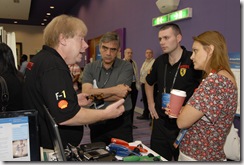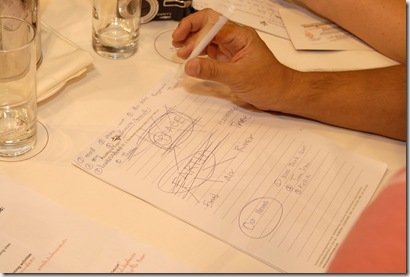Innovative Teachers, This Time in Hong Kong
It’s time again for Microsoft’s Innovative Teacher’s Forum (ITF), an annual event where we celebrate the 100 or so coolest teachers from around the world, all who are doing great things in terms of integrating technology into their classrooms. This year the event is taking place in Hong Kong. You can learn more about ITF here, including a list of the conference winners. But in my opinion they are all winners.
I attended last year’s event in Helsinki, and thought it was the best Microsoft show I’ve been to in a long time. I am in India this week doing consumer research and cannot be in Hong Kong, but my colleague Andy Woolnaugh has provided me an update on what is going at this year’s conference.
What is especially cool about the examples I am highlighting is that they all use a combination of PCs and cell phones to deliver a great learning experience regardless of where the students are located. These are exactly the sort of scenarios that Ray Ozzie and team discussed at the PDC last month, sort of a “Life Without Walls” but it is taking place in classrooms today.
 In Northern Ireland, Tom Fitzsimmons and Ciaran McLaren have developed a project to teach vocational engineering to students entirely using online channels and tools that the students use themselves in everyday life. The project is also being shared with schools in Wales, Scotland, England, Germany and Austria. The students design formula one car models, and then use video conferencing, live webcasts and other online communications to speak to Silverstone Formula 1 engineers and Royal Air Force aerodynamics experts to discuss their designs, learn new techniques, refine their projects and get first hand training from the experts. The aim is for students to build and race their model cars. Lesson materials are entirely online, hosted on websites, and students can download workshops as video onto PDAs and smartphones, or onto MP3 and MP4 devices as podcasts so they can listen outside of school. (Live Mesh anyone?)Therefore physical lessons are more interactive and are used to collaborate with each other or external experts helping with their projects. Learning and attendance rates at school have improved and, in an area of relatively high unemployment, the children learning important vocational skills. AND they get to play with race cars!
In Northern Ireland, Tom Fitzsimmons and Ciaran McLaren have developed a project to teach vocational engineering to students entirely using online channels and tools that the students use themselves in everyday life. The project is also being shared with schools in Wales, Scotland, England, Germany and Austria. The students design formula one car models, and then use video conferencing, live webcasts and other online communications to speak to Silverstone Formula 1 engineers and Royal Air Force aerodynamics experts to discuss their designs, learn new techniques, refine their projects and get first hand training from the experts. The aim is for students to build and race their model cars. Lesson materials are entirely online, hosted on websites, and students can download workshops as video onto PDAs and smartphones, or onto MP3 and MP4 devices as podcasts so they can listen outside of school. (Live Mesh anyone?)Therefore physical lessons are more interactive and are used to collaborate with each other or external experts helping with their projects. Learning and attendance rates at school have improved and, in an area of relatively high unemployment, the children learning important vocational skills. AND they get to play with race cars!
%20Semi%20Finals%20announcement_thumb.jpg) In New Zealand, Nathan Kerr, an Onehunga High School geography teacher discussed a project that allows him to deliver teaching material to students via their cell phones. I like this project because it is an example where the students taught the teacher about new ways to apply technology to the learning process.
In New Zealand, Nathan Kerr, an Onehunga High School geography teacher discussed a project that allows him to deliver teaching material to students via their cell phones. I like this project because it is an example where the students taught the teacher about new ways to apply technology to the learning process.
“What happens is that students go on field trips and collect digital images using camcorders or their cell phones. I supervise what they need to take images of so it’s relevant to what they need to know for their end of year exams. When we get back to school the images are collected and stored on a shared drive and I get them to make movies of their field trip. The data is then compressed and transferred to their cell phones through Bluetooth or USB. Their cell phones essentially become notebooks that can take up to 100 little narrated movies on them,” he says.
Kerr says a lot of credit for the mLearning tool needs to go to his students, who raised the idea in the first instance when they heard cell phones could store computer files. Since then they have played an active role in the project, giving Kerr feedback and passing on their extensive knowledge of cell phone and communications technology to Kerr, who admits he was largely in the dark on such matters before he took on the project. While he says the technology to create his mobile learning tool has been around for the better part of a decade, it was his students’ familiarity with such technology that made the project possible.
“This project was completely student-driven. I just mapped out the process for transferring the data and they would look at it and critique it – it was like being graded – and I’d go away and tinker with it a bit more and they’d have another look at it. We’ve now refined it to a point where it’s at a stage where the process is very simple,” he says.
Kerr says the development of the mLearning tool has had a noticeable effect on his students. Not only have they developed an enthusiastic interest in the technological side of the project, they have also become keenly interested in the teaching material itself. He says that before the project, pass rates were at the 50-60% mark. Now they are 80-90%.
“Technology is about teaching students on their terms. Not only do they work harder, smarter and faster, the results are better.”
“They’ve really been getting into the technology and the geography. They seem to be absolutely fascinated with the idea that they can carry around their lessons or projects in a little phone and view their movies any time they want,” he says.
“And, because they can download anyone’s clip, they have been critiquing each other’s material without my prompting. I’ve come across a few lively debates and it’s really exciting to see them getting so involved in the topic.”
Finally, Sarietjie Musgrave is from Bloemfontein, South Africa and is running a project with her students who are using a mixture of desktop and mobile applications to offer help to people in the local community with disabilities, and also to spread awareness of how the community can help people with disabilities. She thought it was important for the children not only to develop theoretical solutions to help the disabled community, but that those solutions had to be practicable, and unique to the person they were helping. So from one project, around 60 mini-projects evolved. For example, one of her students used Clicker to help Julius, who could not speak or use a mouse, to click on his preferences to communicate what he would like to do – and in Afrikaans. Another student wrote an application to help a disabled girl in a rural farm to learn basic shapes and colors in her home. The students were able to develop animations to send to mobile phones to the local community to help raise awareness of their work and the disabled agenda.
These projects used PCs and phones in a way that demonstrates how technology still has the potential to transform lives in new and innovative ways. This video where Sarietje describes her students’ work is one of the coolest things I have ever seen. I am serious. Check it out:


